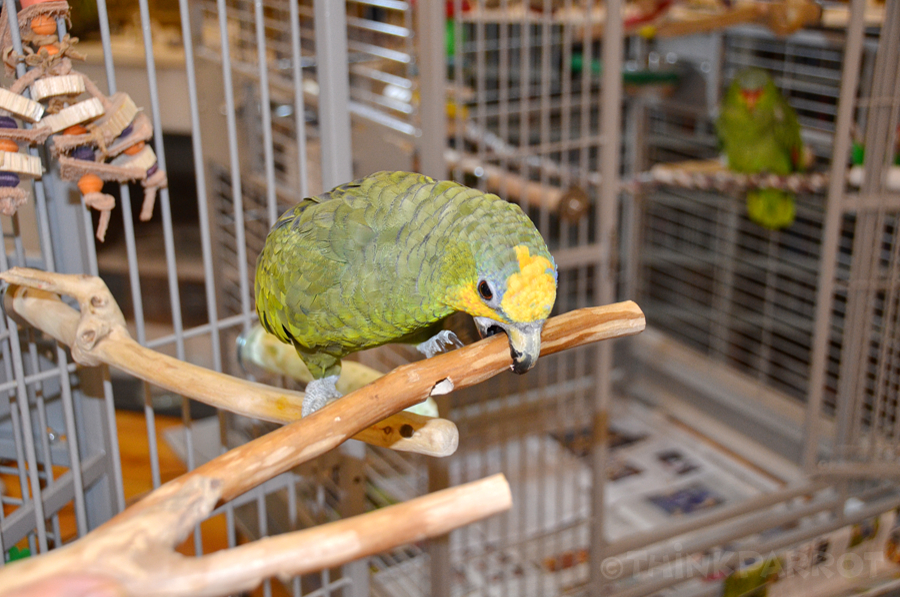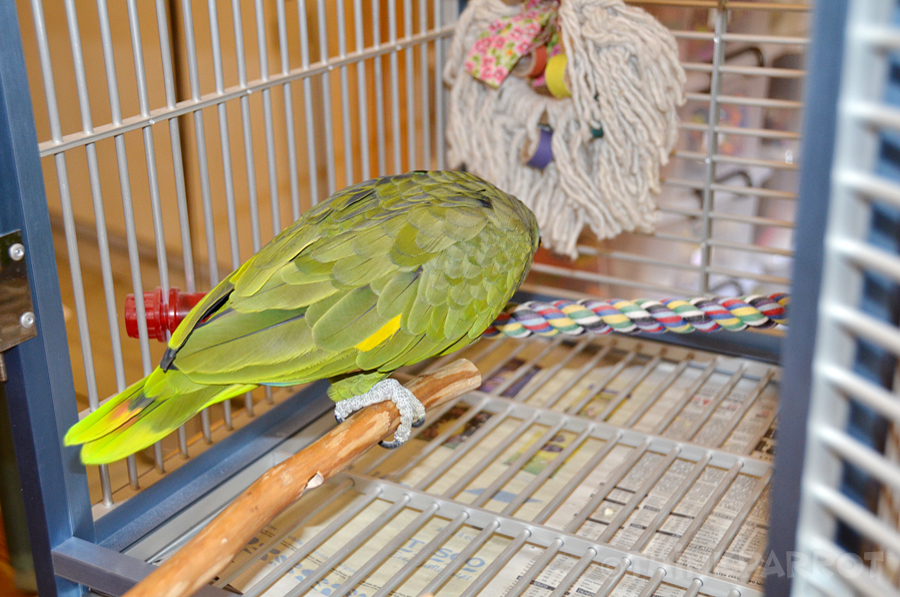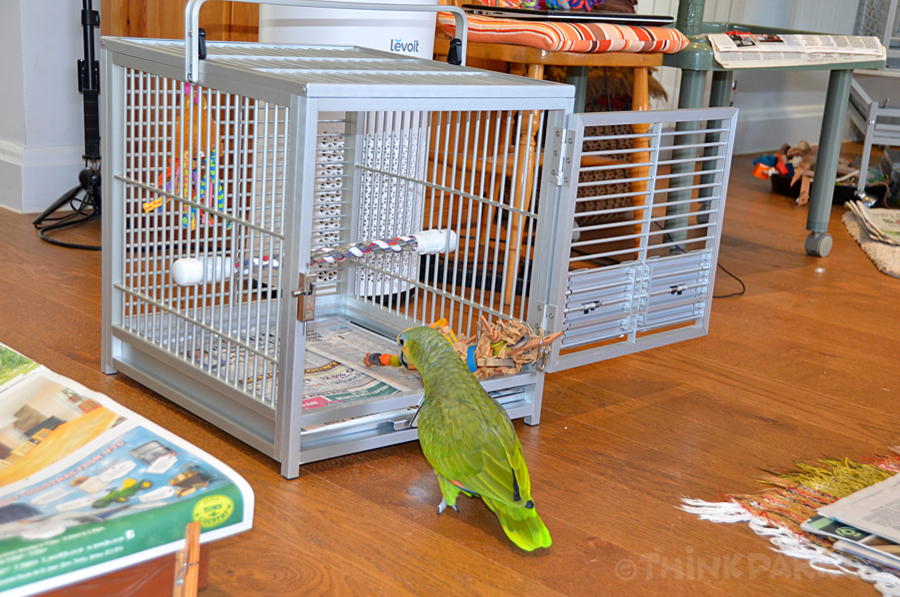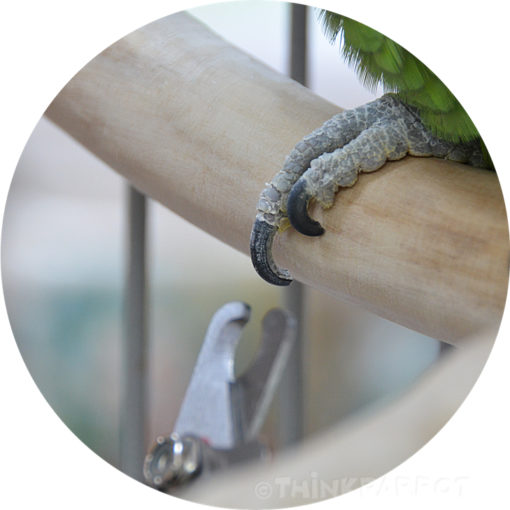One of the most valuable behaviours you can train your parrot to do, is to enter a carrier or crate willingly. It’s a good idea to start training now rather than panicking when your feathered friend suddenly needs to go to the vet or move house etc. There is no need for catching the bird up in a towel and raising stress levels. We can train our parrot to go into his carrier because he/she wants to.
There are a few separate stages involved:
1. We may have to desensitise our parrot to the presence of the carrier
2. Train him/her to approach the carrier
3. Enter the carrier
4. To remain calm when we close the door for increasingly longer periods of time
5. Calm behaviour as we lift and then carry the carrier
I’m going to use Ollie the Orange-winged Amazon as our example because he was so fearful of the carrier and hands.
Systematic Desensitisation
Our parrot may not have seen the carrier before and/or is fearful of it. So begin by desensitising the bird to its presence by gradually bringing it closer to his big cage or stand or wherever he spends most time. This may take a few hours, days or weeks. Each time we bring it slightly closer we make sure not to provoke more than the mildest of aversive reactions. We are looking for relaxed body language – feathers held loosely over the body and head, regular and silent breathing, softly rounded eyes, body upright i.e. not leaning away from the carrier. I placed the carrier on a small table so that Ollie could easily reach it from his big cage door when it was near enough.

After 2 weeks of gradually bringing the carrier closer and closer to his big cage, Ollie decided it was ok to check out. It helped too, to put a couple of favourite toys inside.


Approaching and entering the carrier
There are a few different ways to train a bird to enter a carrier depending on his or her abilities at the time. Choose the way that is easiest for your individual parrot.
Method 1
If the bird is comfortable walking across a flat surface (such as a large table top or floor), then the carrier can be placed on this surface and we can shape his/her walking towards the carrier under his/her own steam. We could do this by having him/her eat treats from our hand and gradually moving that hand towards the carrier where there are more treats scattered at the entrance and inside.
Here is a great video by Lisa Desatnik of ‘So Much Petential’ training her Maximillian’s Pionus, Dreyfuss to go into her carrier using a similar method:
Method 2
Another way is to have the parrot target something like the end of a chopstick, then moving the chopstick increasingly closer to and then inside the carrier in small approximations or steps, each of which are reinforced. The bird would have to know how to target first.
If choosing one of the two methods above, you would then go through the stages of gradually shutting the cage door, lifting and carrying the carrier, as follows:
When the bird is completely relaxed about being inside the carrier, and this includes parrots seemingly unafraid of entering a carrier for the first time, work on gradually closing the carrier door, all the time making sure the bird’s body language remains relaxed.
First step might be just reaching for and touching the carrier door. Then moving it one inch, two inches, 4 inches, etc. until it is briefly closed, then open it again immediately.
Then, watching for relaxed body language, build duration – the amount of time the door is shut.
When the bird is completely relaxed with a shut door, then work on slowly lifing the carrier – 1 inch first, then down again and open the door. Next time, maybe 3 inches in one direction. Build up to eventually carrying the carrier with the bird inside, carefully around the room.
When the behaviour of entering the carrier is fluent, the last thing to do would be to put the behaviour of entering the carrier on a verbal or visual cue. Start off by adding the cue at the same time as the bird steps into the carrier, then gradually bring the cue before the behaviour so that it becomes a proper cue… ie. the antecedent to the behaviour.
Method 3
Because, at the time of training, Ollie wasn’t comfortable on flat surfaces, I decided to place the carrier on a small table near his big cage. I would carry him from his big cage to the carrier on a hand held perch he was already familiar with. The hand held perch was used because Ollie also found hands aversive. I would do this in small, manageable approximations. Reinforcement for each successful approximation would be a piece of cashew – one of Ollie’s favourite treats. Reinforcers for another bird might be anything from a head scratch, to access to an interesting toy.
The first approximation was to have Ollie step up onto the hand held perch and move him a few inches towards the carrier. I was looking to reinforce his relaxed body language (RBL). “YAY” – treat! Then immediately move him and the hand held perch back to his big cage again so that he could step off to safety.

The second approximation was to have him step up on the hand held perch again and move him slightly nearer to the carrier. RBL. “YAY” – treat! And back again.
It was important to return him to his big cage each time so that he remained in control of what was happening. Control is a primary reinforcer.
Each successive approximation took him gradually nearer to the carrier door. RBL earned him a “YAY” followed by a treat! And back to his big cage.
All the time I was looking for his RBL. Go at the speed the bird is comfortable with. If the body language changes, I have gone too far too fast. I need to take a couple of steps back and break the approximations down into even smaller steps.
Going through the carrier door can be a big deal to many birds.

I take him to the carrier door. RBL. “YAY!” But this time I get him to stretch slightly over the threshold for the treat – and back to his big cage.
Another tactic would be to hold on to the treat as he tries to take it, bring him and the treat slightly through the carrier door, then let go and return him immediately to his big cage so that he is still in control.
Gradually each successive approximation takes him closer to the carrier perch.
Again a change of tactic when he’s within reach of the carrier perch: I show him the treat as a lure from the other side of the perch – he has to stretch over the perch to reach it. “YAY” – and back to his big cage.
Next time, he has to reach further for the treat with the idea that eventually he will step on the perch with one foot to reach the treat. Then a few approximations later, two feet. Each time the hand held perch is waiting in exactly the same place for his quick exit.
After a few repetitions, he should be happy enough to step onto the carrier perch and I can start concealing the treat in my fingers again so that he can’t see it. A lure should be used sparingly to kickstart a behaviour and faded out as soon as possible so the bird does not just follow food. Having a favourite toy within reach of the carrier perch is added reinforcement to remain inside the carrier.



Closing the carrier door
When he is stepping onto the carrier perch with regularity, the next stage is to shape duration. Wait a second or two before giving him the treat. “YAY” – then take him out of there.
Next time wait 3 seconds. Treat and out of there.
Then 5 seconds. Treat and out of there.
Then go to touch the carrier door. Treat and out of there.
Then move the carrier door half a centimetre. Treat and out of there.
Then move the carrier door a couple of inches. Treat and out of there.
And so on until you can briefly shut the door and open it again. Treat and out of there.
Then shut the door for 1 second. Open it. Treat and out of there.
Shut the door for 2 seconds. Open it, treat and out of there.
Gradually build up the time the door is shut, constantly watching for RBL. If the body language changes slightly, immediately swing the door open and get him out of there. Then go back a couple of steps and build up more slowly.
Working on closing the carrier door took the most time with Ollie.

Lifting and carrying the crate
When our parrot is comfortable inside the carrier with the door closed, work on lifting the carrier, again using small steps.
Lift the carrier a centimetre. Down again, swing the door open. Treat and out of there.
Gradually build on lifting for longer all the time paying close attention to body language.
Then lift and walk a step or two with the carrier and gradually increase the distance.
Crate training was a lot to ask of Ollie so the treats I gave him were a little bigger than usual. Sometimes he even got a jackpot of a big palm nut and was happy enough to stay in the carrier to eat it.

When we moved house it was a huge plus for Ollie to be able to calmly enter the carrier of his own free will. What a difference the journey was compared to a few years earlier when I had to towel him to go to the vet since I hadn’t yet had the chance to crate train him. When we arrived at the vet, the vet was genuinely concerned at the fearful state he was in. Being able to enter the carrier calmly set Ollie up for an unbelievably laid back 12+ hours travelling by car and ferry. That story can be seen here.
I hadn’t asked Ollie to go back into the carrier since we arrived in our new house. One year later, I was interested in seeing how long it would take to teach him again. By this time Ollie was more adventurous, so first I set up the carrier in the “bird room” so that he could see it every day and could access it if he wanted to. He was curious and relaxed as he explored in his own time in various places.


Then I began shaping the behaviour. Watching his body language carefully, the first approximation was to carry him to the carrier door then back to his big cage. I was looking for RBL all the time. Our third approximation a few minutes later had him calmly stepping down onto the carrier perch. We would practice this for a few minutes each night and mix it up with other behaviours… such as a plain step up, targeting and turning a circle. When entering the carrier was fluent, I built on duration – the time he was inside the carrier, and closing the door. As expected, the process was much quicker than the first time I taught him.
A destination which ALWAYS ends up at the vet can later punish the behaviour of entering the carrier. Practice taking your parrot for short drives inside the carrier and making the journey and/or destination FUN!




